Page 64 of 98
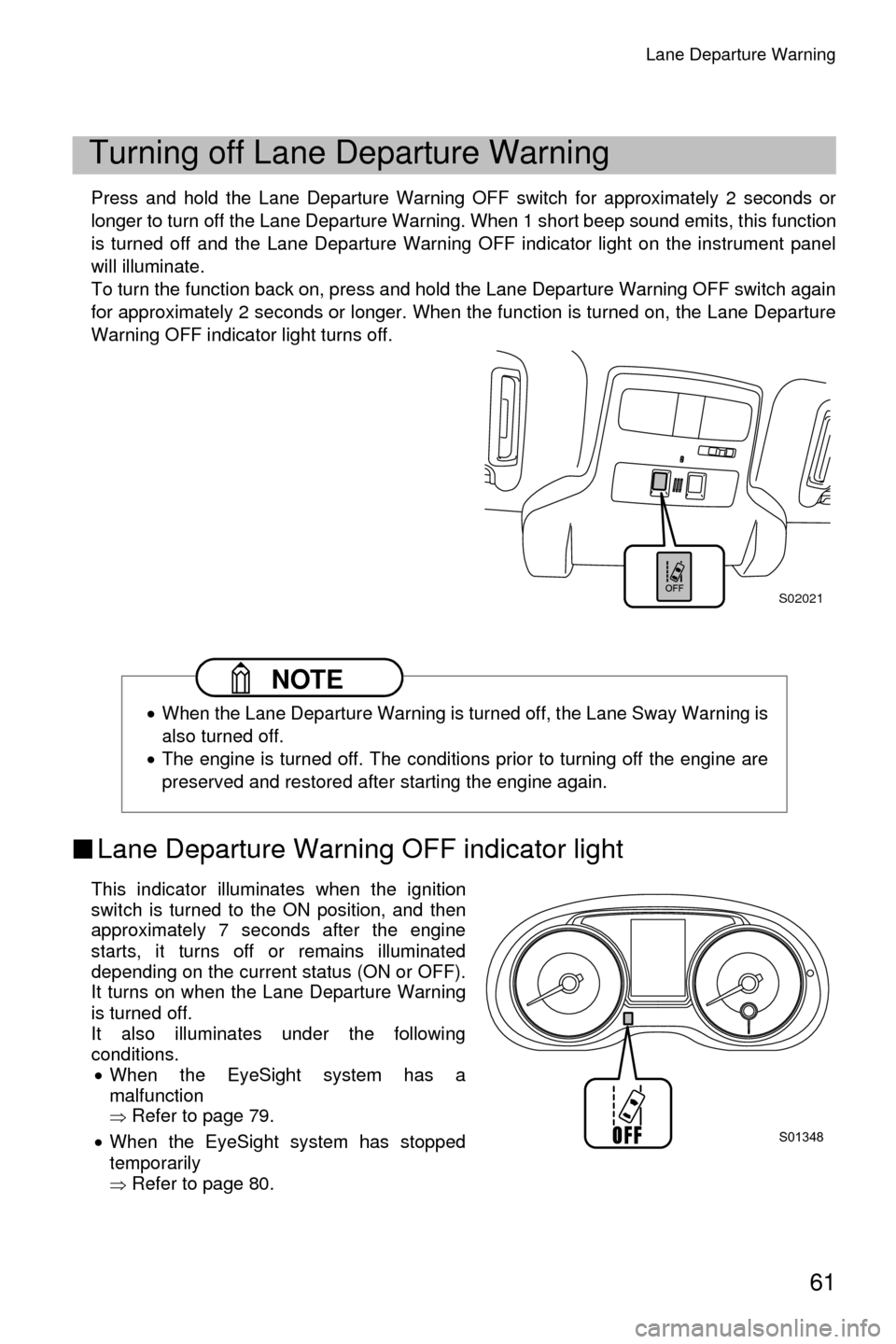
Lane Departure Warning
61
Press and hold the Lane Departure Warning OFF switch for approximately 2 seconds or
longer to turn off the Lane Departure Warning. When 1 short beep sound emits, this function
is turned off and the Lane Departure Warning OFF indicator light on the instrument panel
will illuminate.
To turn the function back on, press and hold the Lane Departure Warning OFF switch again
for approximately 2 seconds or longer. When the function is turned on, the Lane Departure
Warning OFF indicator light turns off.
■Lane Departure Warning OFF indicator light
This indicator illuminates when the ignition
switch is turned to the ON position, and then
approximately 7 seconds after the engine
starts, it turns off or remains illuminated
depending on the current status (ON or OFF).
It turns on when the Lane Departure Warning
is turned off.
It also illuminates under the following
conditions.
• When the EyeSight system has a
malfunction
�Ÿ Refer to page 79.
• When the EyeSight system has stopped
temporarily
�Ÿ Refer to page 80.
Turning off Lane Departure Warning
NOTE
•When the Lane Departure Warning is turned off, the Lane Sway Warning is
also turned off.
• The engine is turned off. The conditions prior to turning off the engine are
preserved and restored after starting the engine again.
S02021
S01348
Page 66 of 98
Lane Sway Warning
63
NOTE
•Wandering detection is based on several minutes of driving data. Wander-
ing will not be detected immediately when it occurs. In addition, the warn-
ing may continue for some time even after wandering stops.
• The Lane Sway Warning System is just a function that warns the driver.
When the driver is tired, not concentrating on the road or not paying ade-
quate attention to driving, be sure to take rest breaks as often as needed.
• When the Lane Departure Warning OFF indicator light is illuminated, the
Lane Sway Warning will not operate.
�Ÿ Refer to page 61.
Page 67 of 98
Lane Sway Warning
64
Press and hold the Lane Departure Warning OFF switch for approximately 2 seconds or
longer to turn off the Lane Sway Warning. When 1 short beep sound emits, this function is
turned off and the Lane Departure Warning OFF indicator light on the instrument panel illu-
minates.
To turn the function back on, press and hold the Lane Departure Warning OFF switch again
for approximately 2 seconds or longer. When the function is turned on, the Lane Departure
Warning OFF indicator light turns off.
�Ÿ Refer to page 61.
Turning off Lane Sway Warning
NOTE
•When the Lane Sway Warning is turned off, the Lane Departure Warning is
also turned off.
• The engine is turned off. The conditions prior to turning off the engine are
preserved and restored after starting the engine again.
S02021S01348
Page 78 of 98
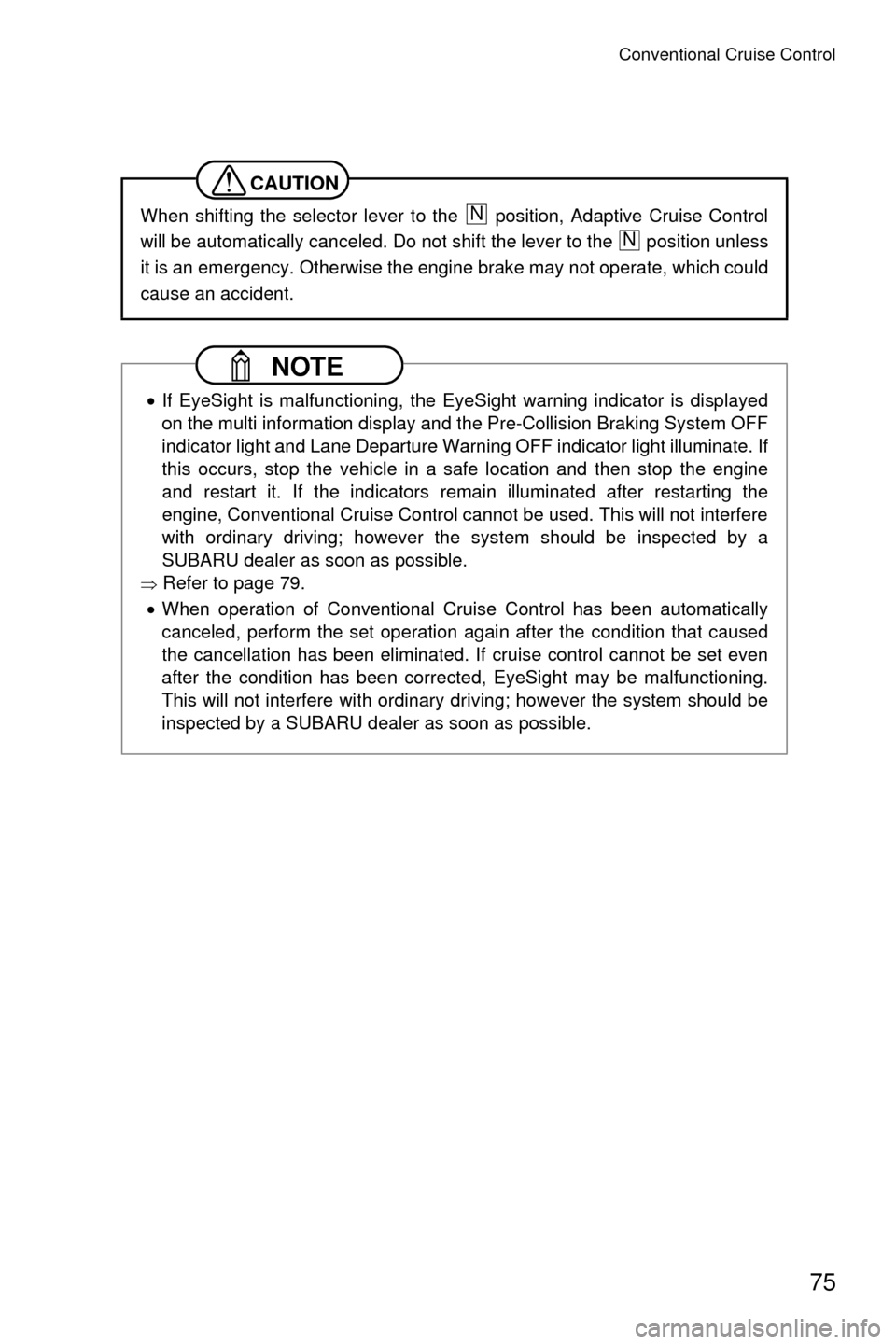
Conventional Cruise Control
75
CAUTION
When shifting the selector lever to the position, Adaptive Cruise Control
will be automatically canceled. Do not shift the lever to the position unless
it is an emergency. Otherwise the engine brake may not operate, which could
cause an accident.
NOTE
•If EyeSight is malfunctioning, the EyeSight warning indicator is displayed
on the multi information display and the Pre-Collision Braking System OFF
indicator light and Lane Departure Warning OFF indicator light illuminate. If
this occurs, stop the vehicle in a safe location and then stop the engine
and restart it. If the indicators remain illuminated after restarting the
engine, Conventional Cruise Control cannot be used. This will not interfere
with ordinary driving; however the system should be inspected by a
SUBARU dealer as soon as possible.
�Ÿ Refer to page 79.
• When operation of Conventional Cruise Control has been automatically
canceled, perform the set operation again after the condition that caused
the cancellation has been eliminated. If cruise control cannot be set even
after the condition has been corrected, EyeSight may be malfunctioning.
This will not interfere with ordinary driving; however the system should be
inspected by a SUBARU dealer as soon as possible.
N
N
Page 82 of 98
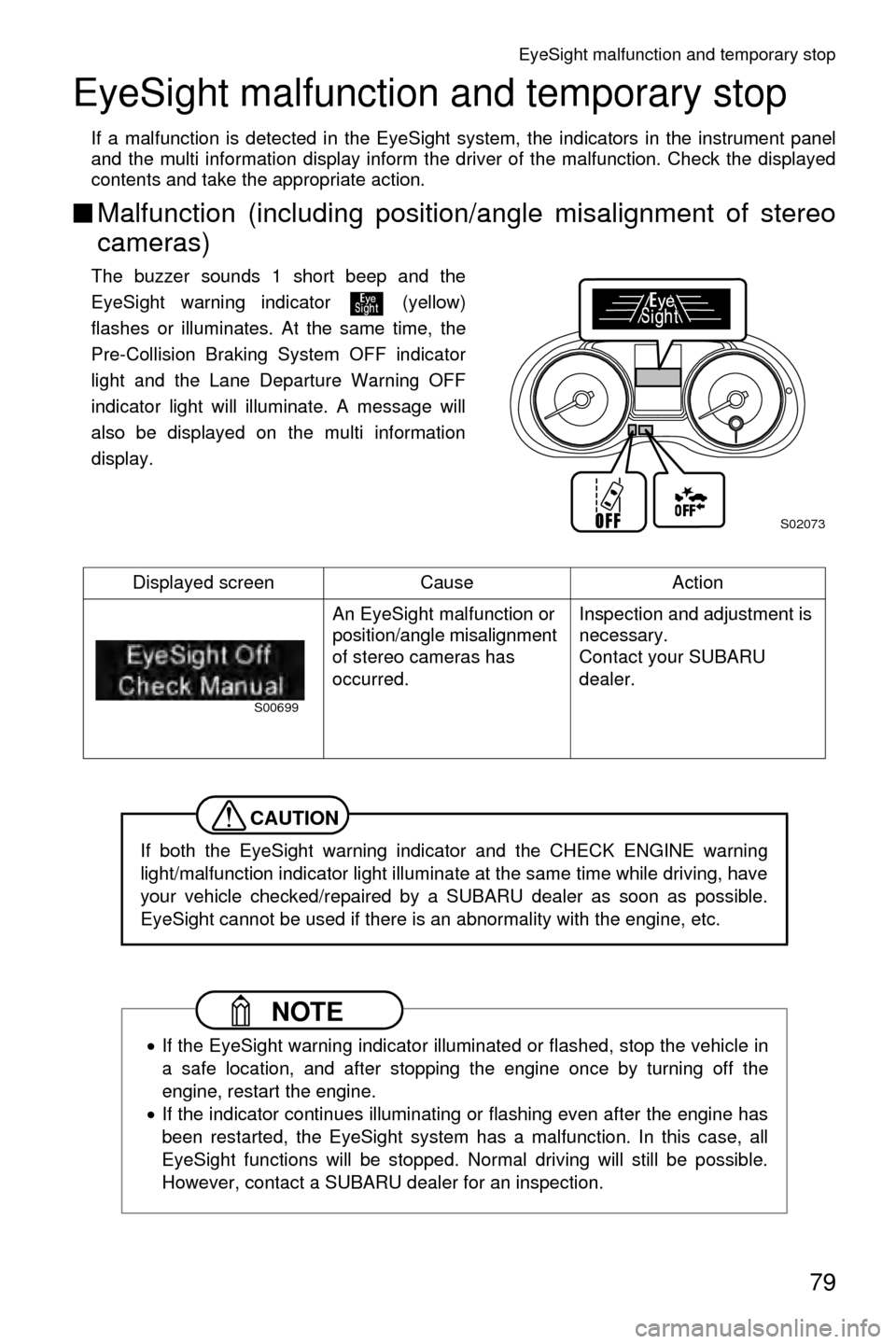
EyeSight malfunction and temporary stop
79
EyeSight malfunction and temporary stop
If a malfunction is detected in the EyeSight system, the indicators in the instrument panel
and the multi information display inform the driver of the malfunction. Check the displayed
contents and take the appropriate action.
■ Malfunction (including position/angle misalignment of stereo
cameras)
The buzzer sounds 1 short beep and the
EyeSight warning indicator (yellow)
flashes or illuminates. At the same time, the
Pre-Collision Braking System OFF indicator
light and the Lane Departure Warning OFF
indicator light will illuminate. A message will
also be displayed on the multi information
display.
Displayed screen Cause Action An EyeSight malfunction or
position/angle misalignment
of stereo cameras has
occurred. Inspection and adjustment is
necessary.
Contact your SUBARU
dealer.
CAUTION
If both the EyeSight warning indicator and the CHECK ENGINE warning
light/malfunction indicator light illuminate at the same time while driving, have
your vehicle checked/repaired by a SUBARU dealer as soon as possible.
EyeSight cannot be used if there is an abnormality with the engine, etc.
NOTE
•
If the EyeSight warning indicator illuminated or flashed, stop the vehicle in
a safe location, and after stopping the engine once by turning off the
engine, restart the engine.
• If the indicator continues illuminating or flashing even after the engine has
been restarted, the EyeSight system has a malfunction. In this case, all
EyeSight functions will be stopped. Normal driving will still be possible.
However, contact a SUBARU dealer for an inspection.
S02073
S00699
Page 83 of 98
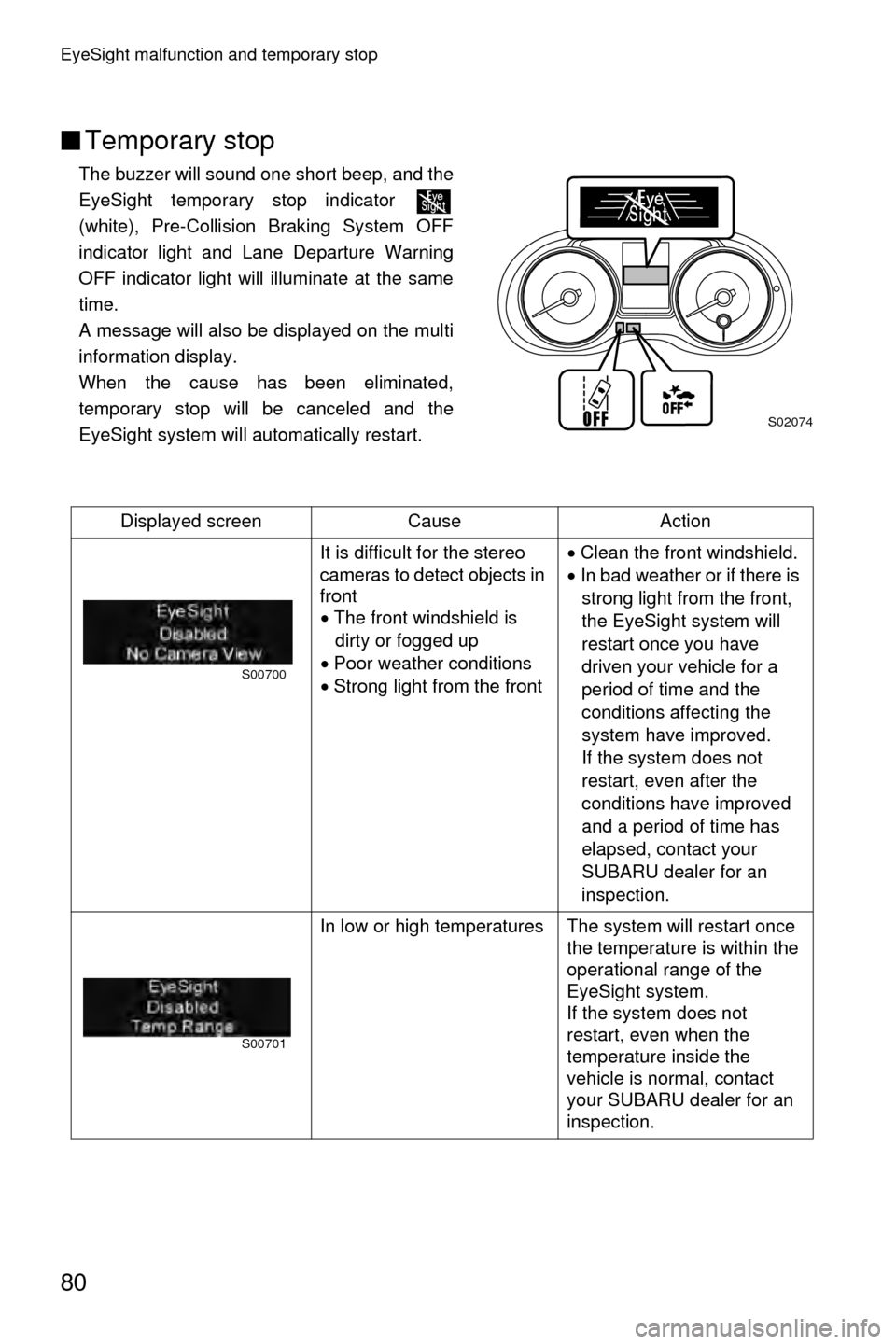
EyeSight malfunction and temporary stop
80
■Temporary stop
The buzzer will sound one short beep, and the
EyeSight temporary stop indicator
(white), Pre-Collision Braking System OFF
indicator light and Lane Departure Warning
OFF indicator light will illuminate at the same
time.
A message will also be displayed on the multi
information display.
When the cause has been eliminated,
temporary stop will be canceled and the
EyeSight system will automatically restart.
Displayed screen Cause Action It is difficult for the stereo
cameras to detect objects in
front• The front windshield is
dirty or fogged up
• Poor weather conditions
• Strong light from the front •
Clean the front windshield.
• In bad weather or if there is
strong light from the front,
the EyeSight system will
restart once you have
driven your vehicle for a
period of time and the
conditions affecting the
system have improved.
If the system does not
restart, even after the
conditions have improved
and a period of time has
elapsed, contact your
SUBARU dealer for an
inspection.
In low or high temperatures The system will restart once the temperature is within the
operational range of the
EyeSight system.
If the system does not
restart, even when the
temperature inside the
vehicle is normal, contact
your SUBARU dealer for an
inspection.
S02074
S00700
S00701
Page 91 of 98
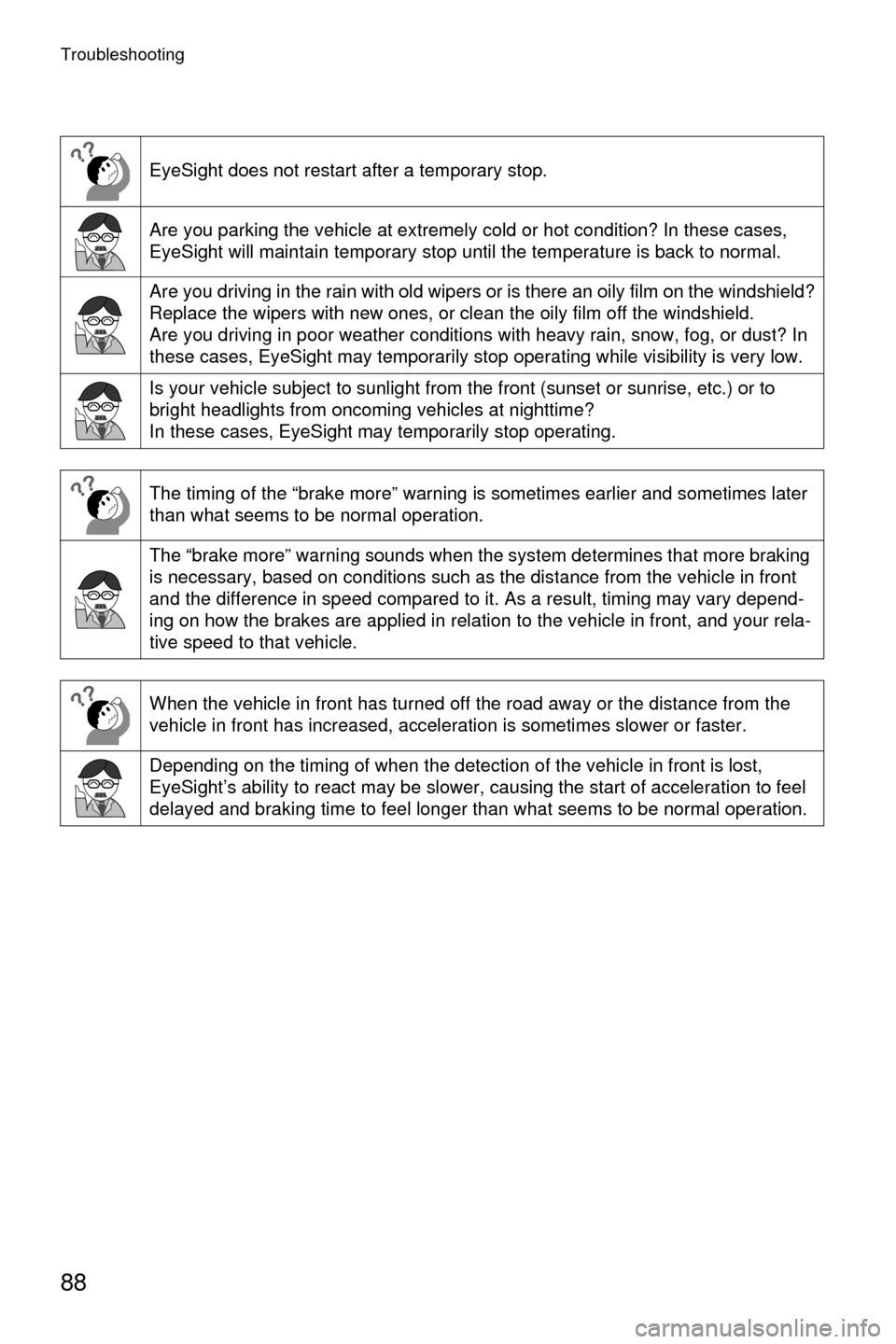
Troubleshooting
88
EyeSight does not restart after a temporary stop.
Are you parking the vehicle at extremely cold or hot condition? In these cases,
EyeSight will maintain temporary stop until the temperature is back to normal.
Are you driving in the rain with old wipers or is there an oily film on the windshield?
Replace the wipers with new ones, or clean the oily film off the windshield.
Are you driving in poor weather conditions with heavy rain, snow, fog, or dust? In
these cases, EyeSight may temporarily stop operating while visibility is very low.
Is your vehicle subject to sunlight from the front (sunset or sunrise, etc.) or to
bright headlights from oncoming vehicles at nighttime?
In these cases, EyeSight may temporarily stop operating.
The timing of the “brake more” warning is sometimes earlier and sometimes later
than what seems to be normal operation.
The “brake more” warning sounds when the system determines that more braking
is necessary, based on conditions such as the distance from the vehicle in front
and the difference in speed compared to it. As a result, timing may vary depend-
ing on how the brakes are applied in relation to the vehicle in front, and your rela-
tive speed to that vehicle.
When the vehicle in front has turned off the road away or the distance from the
vehicle in front has increased, acceleration is sometimes slower or faster.
Depending on the timing of when the detection of the vehicle in front is lost,
EyeSight’s ability to react may be slower, causing the start of acceleration to feel
delayed and braking time to feel longer than what seems to be normal operation.